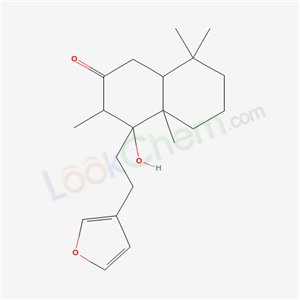Multi-step reaction with 15 steps
1.1: diisopropylamine; n-Buli / tetrahydrofuran; hexane / 0.75 h / 0 °C
1.2: 83 percent / tetrahydrofuran; hexane / 0.83 h / 20 °C
2.1: 94 percent / benzyltrimethylammonium fluoride / tetrahydrofuran / 0.5 h / 20 °C
3.1: 97 percent / pyridinium bromide perbromide / acetic acid / 2 h / 20 °C
4.1: 94 percent / 1,8-diazabicyclo[5.4.0]undec-7-ene / toluene / 2 h / Heating
5.1: 99 percent / diethyl ether / -78 - 20 °C
6.1: 98 percent / N,N-dimethylaminopyridine / tetrahydrofuran / 21 h / 20 °C
7.1: 80 percent / Pd(PPh3)4; CuI / diethylamine / 12 h / Heating
8.1: 98 percent / n-Bu4NF / tetrahydrofuran / 0.33 h / 0 °C
9.1: 78 percent / pyridinium chlorochromate / CH2Cl2 / 58 h / 20 °C
10.1: 85 percent / H2; aq. KOH / Pd/C / methanol / 0.12 h
11.1: 98 percent / NaBH4; CeCl3*7H2O / methanol / 0.08 h / 0 °C
12.1: 92 percent / imidazole / dimethylformamide / 0 - 20 °C
13.1: 70 percent Turnov. / NaHCO3; m-chloroperoxybenzoic acid / CH2Cl2 / 12 h / 0 °C
14.1: 88 percent / n-Bu4NF / tetrahydrofuran / 0 - 20 °C
15.1: LiAlH4 / tetrahydrofuran / 1 h / 20 °C
15.2: 79 percent / pyridinium dichromate / CH2Cl2 / 0.75 h / 20 °C
With
1H-imidazole; dmap; potassium hydroxide; sodium tetrahydroborate; copper(l) iodide; lithium aluminium tetrahydride; tetrakis(triphenylphosphine) palladium(0); n-butyllithium; cerium(III) chloride; tetrabutyl ammonium fluoride; hydrogen; pyridinium hydrobromide perbromide; trimethyl(benzyl)ammonium fluoride; sodium hydrogencarbonate; 1,8-diazabicyclo[5.4.0]undec-7-ene; diisopropylamine; 3-chloro-benzenecarboperoxoic acid; pyridinium chlorochromate;
palladium on activated charcoal;
In
tetrahydrofuran; methanol; diethyl ether; hexane; dichloromethane; acetic acid; diethylamine; N,N-dimethyl-formamide; toluene;
1.1: Metallation / 1.2: silylation / 2.1: Methylation / 3.1: Bromination / 4.1: Dehydrobromination / 5.1: Addition / 6.1: Substitution / 7.1: Substitution / 8.1: desilylation / 9.1: Oxidation / 10.1: Catalytic hydrogenation / 11.1: Reduction / 12.1: Substitution / 13.1: Epoxidation / 14.1: desilylation / 15.1: Reduction / 15.2: Oxidation;
DOI:10.1016/S0040-4020(99)00627-4




